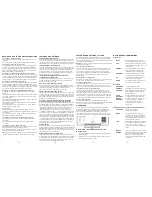
1
2
3
4
250030-01
Installation and Operation
Instructions for
RS332NE
3-Heat / 2-Cool
Non-Programmable
Setback Thermostat
with Economizer Control
with the Industry’s Most
Advanced Remote Sensor Bus
for Gas, Electric, & Heat Pump Systems
www.robertshawclimate.com
TABLE OF CONTENTS
Introduction…………………………………………………
2
Standard Features………………………………………...
2
Button Operations…………………………………………
3
Thermostat Locations……………………………………..
3
Removing The Thermostat From The Backplate………
4
Description Of The Dip Switch Functions………………
5
Features And Settings……………………………………
6-7
Cover Lock…………………………………………………
7
Replacing The Thermostat On The Backplate…………
7
Button Press Combinations………………………………
8
Keypad Lockout………………………..………………….
9
Temporary Override………………………………………
9
Setback Input Terminals – Special Functions..………..
9
Changing Fahrenheit (°F) To Celsius (°C)……………..
10
Power Failures…………………………………………….
10
Remote Sensors (Optional)………………………………
10
Setup Menu……………………………………………….. 10-11
Wiring Diagrams………………………………………….. 11-20
Specifications………………………………………………
21
Sensor Faults……………………………………………...
21
Description Of Icons……………………………………… 22-23
Display………………………………………………………
23
Warranty………………………………………………….... 23-24
INTRODUCTION
The RS332NE Non-Programmable Setback Thermostat with
Economizer Controls represents advanced solid-state,
microcomputer temperature controls. The thermostat incorporates
state-of-the-art technology packaged in an extremely low profile
designer series case. They are a direct replacement for 300
series and DSL series non-programmable units. The Ultra-Touch
push-buttons and easy-to-read, blue backlit LCD display provide
the ultimate in user friendly operation of the heating and air
conditioning, including gas, electric, oil and heat pump systems.
STANDARD FEATURES
•
No batteries required – always remembers setpoints
•
Integrated electronic heat anticipation and cooling droop with
built-in short cycle equipment protection
•
Intelligent Fuzzy Logic staging for efficient operation of
equipment, including auxiliary heat
•
Tamper proof electronic keyboard lockout with
programmable override ranges and time
•
Automatic, Manual and Recirculation Fan operation
•
Adjustable Fan Purge after Heating or Cooling Call
•
Automatic Heat/Cool Changeover, Cooling Only, or Heating
Only Mode Control
•
Adjustable Deadband between Heat & Cool Setpoints in Auto
•
Dual Heating and Cooling Setpoints for Day (Occupied) and
Night (Unoccupied) operation
•
Adjustable Min/Max Setpoints for Heating and Cooling
•
Keypad Lockout with rest/-3°F(2°C) or +/-5°F(3°C)
setpoint adjustment & 0 min to 24 Hr override timer
•
Selectable Fahrenheit or Celsius temperature display
•
Adjustable Backlight Brightness
•
Integrated Installer Setup Menu
•
Economizer option utilizes outdoor air before engaging
compressor for cooling (requires an outdoor sensor)
•
Adjustable outside temperature threshold setpoint for
engaging Economizer, and adjustable delay before a
compressor call.
•
Up to 10 Remote Sensors can be added:
Surface Mount:
•
10-528 or RS300-528 (indoor) (up to 6)
•
10-529 or RS300-529 (outdoor)
Single Gang Box Mount :
•
RS300-530 (Aux 1 – Aux 3)
•
AVAILABLE PROBES FOR RS300-530
•
RS300-531 (6” stainless steel w/box)
•
RS300-532 (direct in-pipe water)
•
Occupancy Sensor Inputs (use RS-OSC or RS-OSW)
•
Two (2) Digital Inputs with LED Indicators
BUTTON OPERATION
THERMOSTAT LOCATION
To ensure proper operation, the thermostat should be mounted
on an inside wall in a frequently occupied area of the space. In
addition, its position must be at least 18” (46 cm) from any
outside wall, and approximately 5’, (1.5 m) above the floor in a
location with freely circulating air of an average temperature.
Be sure to avoid the following locations:
•
Behind doors or in corners where freely circulating air is
unavailable
•
Where direct sunlight or radiant heat from appliances might
affect control operation
•
On an outside wall
•
Adjacent to, or in line with, conditioned air discharge grilles,
stairwells or outside doors
•
Where its operation may be affected by steam or water pipes
or warm air stacks in an adjacent partition, or by any
unheated / uncooled area behind the thermostat
•
Where its operation may be affected by lighting dimmers next
to it
•
Where its operation will be affected by the supply air of an
adjacent unit
•
Near sources of electrical interference such as arcing relay
contact
REMOVING THE THERMOSTAT FROM THE
BACKPLATE
1. Insert a flat blade screwdriver or coin 1/8” into the slot located
in the bottom center of the thermostat case and twist 1/4 turn.
When you feel or hear a click, grasp the case from the bottom
two corners and separate from the backplate as shown in the
diagram at the left. Some models require more force than
others when separating due to the number of terminals used.
2. Swing the thermostat out from the bottom.
3. Lift the thermostat up and off the backplate.
4. Place the rectangular opening in the backplate over the
equipment control wires protruding from the wall and, using
the backplate as a template, mark the location of the two
mounting holes
NOTE:
There are several versions of the RS300N thermostat.
The wiring instructions for the equipment are identical.
5. Use the supplied anchors and screws for mounting on drywall
or plaster; drill two 3/16” (5mm) diameter holes at the marked
locations; use a hammer to tap the nylon anchors in flush to
the wall surface and fasten backplate using the supplied
screws. (Do not over tighten!)
6. Connect the wires from your system to the thermostat
terminals as shown in the wiring diagrams. Carefully dress the
wires so that any excess is pushed back into the wall cavity or
junction box. Ensure that the wires are flush to the plastic
backplate. The access hole should be sealed or stuffed to
prevent drafts from affecting the thermostat.
NOTE:
This product must be supplied from a UL/CSA
LISTED Class 2 power supply. Operation from other supplies
may result in a potential fire risk.
Summary of Contents for RS332NE
Page 4: ...13 14 15 16...
Page 5: ...17 18 19 20...
























